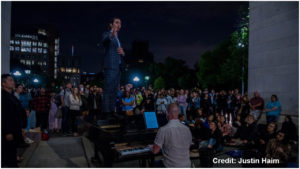
Opera Under the Arch 2019 Review
Student Artists Make for Stunning Showcase of Arias and Duets
By Logan MartellAs the summer inches closer, lovers of opera and the performing arts can enjoy a number of smaller, independent productions throughout New York City. Naturally, one would not expect to see an opera singer delivering arias from on top of a piano in the middle of Washington Square Park, but that’s exactly what happens with Opera Under the Arch. The concert series comes as a collaboration between baritone Sung Shin, music director Andrew King, and pianist Colin Huggins, who moves the 800-pound instrument personally; their aim is to easily deliver to the people performances that catch the eye and stir the heart. Most, if not all, of the young artists are students or recent graduates of the Manhattan School of Music, putting their passion and what they’ve learned on full display.
Saturday’s performance was broken into three sets, with a 15-minute interval between sets comprised of a modest but solid handful of arias and duets. Each set did not fail to gather a fair-sized audience and gain the attention of people passing by.
“Get On My Piano!”
Opening the evening’s concert was tenor Andrew Hoben, singing “La Danza” from Rossini’s “Les soirees musicales.” The flighty accompaniment of this patter song was wonderfully met by Hoben’s rapid delivery of the text, retaining the ability to accurately hit his mark with the outpouring of syllables. Following a series of vocal runs, Hoben brought the first number of the night to a powerful conclusion. Later, Hoben sang “O Columbina,” from Leoncavallo’s “Pagliacci.” His romantic pining saw expression in softer, sustained phrases which unfolded with delicacy before Hoben finished with a passionate B-flat ending.
Making an early impression was soprano Evangeline Ng, singing “O mio babbino caro,” from Puccini’s “Gianni Schicchi.” Carrying less of Lauretta’s pleading, Ng’s brighter energy beautifully carried over to the color and ease of her soaring phrases; still very much in control, she brought this number to a gentle landing and great applause. Ng’s vivacity did much to bolster one of her later numbers “Je veux Vivre,” from Gounod’s “Romeo et Juliette.” Maintaining her support in spite of the chilly night wind, Ng’s series of ornaments led into a brilliant, exulting cadenza that made for one of the evening’s highlights.
Making her Under the Arch debut was mezzo-soprano Gabriella Chea, singing “Va! Laisse couler mes larmes,” from Massenet’s “Werther.” After being assisted onto the piano, Chea’s smiling demeanor vanished before her tremendous opening, with her projection carrying well through the park’s open air. This starting power, coupled with Chea’s taken aback physicality, conveyed Charlotte’s emotional outpouring as being nearly a deluge of musical and vocal colors. Her later number “Cury mury fuk,” from Dvorak’s “Rusalka,” saw Chea wielding shorter, conjuring phrases as she stepped into the shoes of Jezibaba. Playing to the crowd, Chea seemed to enlist their aid in the witch’s deeds, backed by the accompaniment’s light, almost dancing melody, before dismissing them with a sharp, sassy ending.
Another debutant of the series was baritone Jonathan Brakatselos, performing “O du, Mein Holder Abendstern,” from Wagner’s “Tannhauser.” Brakatselos’ firm delivery and vocal presence were highlighted by the affectionate, and devoted tones he brought to Wolfram’s prayer. A more animated change came for one of his later numbers with Sung Shin which closed the first set, the duet “Cheti cheti immantinente,” from Donizetti’s “Don Pasquale.” While the more conversational aspects of the opening phrases were less audible, this bump smoothed out as the musical and dramatic urgency rose to fun, frantic heights. The two vocally sparred before uniting on top of the piano for the patter section which triumphantly capped the duet and was answered with great applause.
Performing with Purpose
On the beginnings of Opera Under the Arch, co-producer Colin Huggins says “One of the elements that makes street performances work is they have some kind of spectacle, and I thought: ‘You know what? No one’s bringing a piano around.’ People don’t walk into a park expecting to see a grand piano. The greater you are able to break people’s expectations, the more likely you are to engage an audience.”
“I was walking by Washington Square Park, and I heard a piano,” says Shin. “Because I had just come from an audition, I had a backpack full of music that I was singing, and I thought: ‘What if I just asked the guy to play for me?’ So he did… it eventually developed into this whole opera at Washington Square Park.”
As Opera Under the Arch continues as a series, the artists and team behind these performances will no doubt continue to offer a highly-accessible experience for the public to share in what makes opera so effective at touching people’s hearts. On this, Shin affirms: “It’s fantastic to see that we can reach a new audience and really show opera for what it is; the true beauty of a well-used human voice, and intimate artistry.”


